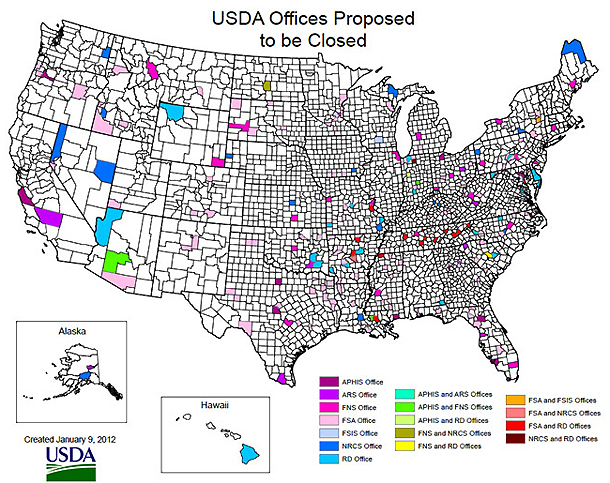 Media releases from the United States Department of Agriculture:
Media releases from the United States Department of Agriculture:
EDITOR’S NOTE: Today, Secretary of Agriculture Tom Vilsack outlined a new plan called the “Blueprint for Stronger Service”
The measures involve consolidating and streamlining operations, and there will be numerous office closures across the country.
The Big Island will be affected. The USDA says Hawaii County’s Hilo hub will be one of 43 area and sub offices in 17 states to lose a Rural Development Mission Area office.
In all, the USDA plans to close 259 domestic offices, facilities and labs across the country.
From the USDA media release:
Agriculture Secretary Vilsack Announces Blueprint for Stronger Service to Increase Efficiency in USDA Operations
Streamlined, Modernized Department Central to 21st Century USDAWASHINGTON, Jan. 9, 2011-The U.S. Department of Agriculture (USDA) must be built to meet the evolving needs of a 21st century agricultural economy, Agriculture Secretary Tom Vilsack said Monday in presenting USDA’s Blueprint for Stronger Service, a plan that helps producers continue to drive America’s economy by streamlining operations and cutting costs.
“The USDA, like families and businesses across the country, cannot continue to operate like we did 50 years ago,” said Vilsack. “We must innovate, modernize, and be better stewards of the taxpayers’ dollars. We must build on the record accomplishments of farm communities in 2011 with a stronger, more effective USDA in 2012 and beyond.”
The Blueprint for Stronger Service is based on a Department-wide review of operations conducted as part of the Administration’s Campaign to Cut Waste, launched by President Obama and Vice President Biden to make government work better and more efficiently for the American people. The agency took a hard look at all USDA operations, from headquarters to field offices. The end result is a plan that will create optimal use of USDA’s employees, better results for USDA customers, and greater efficiencies for American taxpayers.
“As part of the Campaign to Cut Waste, the President and I asked all Cabinet Secretaries to make tough choices within their departments to save taxpayer money, eliminate government waste, and allow us to invest in the programs and services the American people need. This announcement by Secretary Vilsack is another example of how this can be done,” said Vice President Biden. “By undertaking a thorough and thoughtful review of his Department, Secretary Vilsack has saved taxpayers millions in travel and printing costs and is consolidating more than 700 different cell phone contracts into about 10. What’s more, the Department is finding significant savings by consolidating more than 200 offices across the country while ensuring that the vital services they provide are not cut.”
“In the past few decades, U.S. agriculture has become the second most productive sector of the American economy, thanks to farmers adopting technology, reducing debt, and effectively managing risk,” said Vilsack. “These are lessons from which we can all learn. As we continue to invest in rural communities across the country, USDA has heard from producers about reducing red tape and the need to modernize its services. Today, we are answering the challenge by announcing a series of efforts to help us continue to streamline operations, make the best use of taxpayer resources, and provide the best possible service to the American people.”
The USDA will close 259 domestic offices, facilities and labs across the country, as well as seven foreign offices. In some cases, offices are no longer staffed or have a very small staff of one or two people; many are within 20 miles of other USDA offices. In other cases, technology improvements, advanced service centers, and broadband service have reduced some need for brick and mortar facilities.
When fully implemented, these actions along with other recommended changes will provide efficiencies valued at about $150 million annually-and eventually more based on future realignment of the workforce-and will ensure that USDA continues to provide optimal service to the American people within available funding levels. These actions and plans to close or consolidate facility, office and lab operations will impact USDA headquarters in Washington and in 46 states and 1 U.S. territory.
- Farm Service Agency (FSA): Consolidate 131 county offices in 32 states; more than 2,100 FSA offices remain throughout the United States
- Foreign Agricultural Service (FAS): Close 2 country offices; more than 95 FAS offices remain throughout the world
- Animal and Plant Health Inspection Service (APHIS): Close 15 APHIS offices in 11 states and 5 APHIS offices in 5 foreign countries; more than 560 APHIS offices remain throughout the United States and 55 remain throughout the world
- Rural Development (RD): Close 43 area and sub offices in 17 states and U.S. territories; approximately 450 RD offices remain throughout the United States
- Natural Resources Conservation Service (NRCS): Close 24 soil survey offices in 21 states; more than 2,800 NRCS offices remain throughout the United States
- Food Safety and Inspection Service (FSIS): Close 5 district offices in 5 states; 10 district offices remain throughout the United States
- Agricultural Research Service (ARS): Close 12 programs at 10 locations; more than 240 programs remain throughout the United States.
- Food, Nutrition and Consumer Services (FNCS): Close 31 field offices in 28 states; 32 FNCS offices will remain throughout the United States
In addition, USDA is implementing a series of other changes that will save taxpayers’ money while eliminating redundancies and inefficiencies. The Blueprint for Stronger Service details 133 recommendations that affirm processes already in place, as well as 27 initial improvements, and other, longer-term improvements.
The initial improvements include the following:
- Consolidate more than 700 cell phone plans into about 10;
- Standardize civil rights training and purchases of cyber security products; and
- Ensure more efficient and effective service to our employees by moving toward more centralized civil rights, human resource, procurement, and property management functions, creating millions of dollars in efficiencies without sacrificing the quality of our work.
The Secretary detailed the changes in a speech today at the American Farm Bureau Federation’s 93rd Annual Meeting, where he also highlighted the impressive achievements of American agriculture over the past three years. Currently, U.S. agriculture is experiencing its most productive period in history thanks to the resiliency, resourcefulness, and efficiency of American producers. The Blueprint for Stronger Service will allow USDA to continue the investments that help to make this possible.
More from the USDA on the Rural Development closures, which will impact Hawaii Island:
Rural Development
The U.S. Department of Agriculture’s (USDA) Blueprint for Stronger Service is key to building a modern and efficient service organization that is closely in tune with the long-term vitality of rural America and the success of American agriculture. The plan takes a realistic view of the needs of American agriculture in a challenging budget climate, and lays out USDA’s plans to modernize and accelerate service delivery while improving the customer experience through use of innovative technologies and business solutions.
Ultimately, these improvements will help producers and businesses continue to drive America’s economy and respond to 21st century agricultural challenges.
USDA is proud of our work and partnership with America’s farmers, ranchers and rural communities. Today, American agriculture is a bright spot in the nation’s economy, with record income and exports. Over three years as USDA has made record investments in rural America, unemployment in rural America has fallen faster than in other parts of the country. During that same time, USDA has also looked closely at the way it does business. A Blueprint for Stronger Service helps to preserve this success and the USDA investments that helped to make them possible in the long term.
Over the past three years, USDA’s Rural Development Mission Area (RD) has worked hard to do more with less. To manage current and future budget challenges, and to ensure critical investments in rural America continue, RD took a variety of steps to cut costs and improve services, including:
- Cut travel and conference budgets;
- Since 2002, RD has reduced its staff years by 963;
- Continued implementation of a common application process and uniform documentation requirements, making it easier for customers to apply for multiple programs at once, with the potential to save 140,000 customer hours; and
- RD implemented a revised fee structure in 2011 for single family home loans that allows local lenders to provide greater access to mortgage credit across rural America to creditworthy rural applicants. The guaranteed loan program provided over 130,000 homeownership opportunities to rural residents.
A Blueprint for Stronger Service details a list of recommendations: 133 recommendations affirm processes already in place, 27 serve as initial improvements, and others are aimed at longer-term improvements. The initial improvement recommendations include the following:
- Consolidate more than 700 cell phone plans into about 10;
- Standardize civil rights training and purchases of cyber security products;
- Ensure more efficient and effective service to our employees by moving toward more centralized civil rights, human resource, procurement, and property management functions, creating millions of dollars in efficiencies without sacrificing the quality of our work.Budget reductions, staff attrition and increased workload also necessitated a review of USDA facilities, offices and lab operations across the country. As part of the Blueprint for Stronger Service, RD plans:
- To close 43 area and sub offices in 17 states. More than 450 RD offices remain throughout the United States. In most cases, offices recommended for closure are either not staffed or staffed with just one or two employees. In other cases, improved technology has reduced the need for these brick and mortar facilities. See table below.
The list below details the states and corresponding counties where RD offices will be closed.
1. Alabama: Houston County
2. Arizona: Mohave County
3. Arkansas: Izard, Faulkner, Hot Spring, White, and Sevier Counties
4. Delaware: Kent and Sussex Counties
5. Hawaii: 1)(Kosrae, Chuuk, and Yap), and 2) Hawaii County
6. Indiana: Monroe, Tippecanoe, LaPorte, and Marshall Counties
7. Louisiana: Livingston County
8. Maryland: Calvert, Garrett, and Worcester Counties
9. Mississippi: DeSoto County
10. Missouri: Jasper, Jefferson, Cape Girardeau, and Cole Counties
11. North Carolina: Burke, Chowan, and Caswell Counties
12. Oklahoma: Pushmataha and Pittsburg Counties
13. Pennsylvania: Juniata County
14. South Carolina: Richland and Sumter Counties
15. Tennessee: Anderson, Bedford, Bledsoe, Cannon, Carter, Cocke, Humphreys, Sevier, and
Trousdale Counties
16. Virginia: Essex County
17. Wyoming: Park CountyAs we move forward, USDA will continue to find ways to modernize its services, improve the customer experience, and ensure a successful, sustainable future for rural America.


by Big Island Video News5:55 pm
on at
STORY SUMMARY
Media releases from the United States Department of Agriculture: EDITOR’S NOTE: Today, Secretary of Agriculture Tom Vilsack outlined a new plan called the “Blueprint for Stronger Service” The measures involve consolidating and streamlining operations, and there will be numerous office closures across the country. The Big Island will be affected. The USDA says Hawaii County’s […]